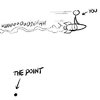When did I say it was unnecessary? I was just asking for clarification, which this community gave (and I'm appreciative).
I'm not challenging the answer, in fact I've said in this thread that it's a good point.
The only point I've made (other than asking a question) is that I believe a pilot can leverage modern avionics to reduce workload, but that was to explain the context of my question - somehow misinterpreted as GPS dependency.
Anyway, you can put down the pitchforks and torches now, and I thank you for the helpful response to my question
I admire your attitude regarding this whole episode. I know it seems you got dumped on by me and perhaps you did.

I hope all is good.
I think most of the subject has been covered but I just want to point out that “the extra workload” you were trying to avoid, is, in fact, the entire point of the exercise.
This is the point in a nutshell. In a training environment, you want it to be hard. For example, if you are training for a race, you don't want to cheat the process. You would run with weights strapped on; up hills, up stairs...anything to build your muscles and for the race to seem easy compared to the training. It's the same thing with pilot training. It needs to be hard or you don't develop the skills...mental skills of being able to fly the plane without conscious thought, knowing how things look at altitude, the feel of the plane, reading charts; computing ETAs, etc. With technology, it is common to see what used to be pilots are really more users of foreflight, people knowledgeable on Garmin navigation boxes, and operators of autopilots.
Let us encourage you to consider not only using visual waypoints, but to use paper charts and manual E6B. Note times of waypoint passage and commute the Groundspeed along with the ETA to next waypoint. This may make things artificially hard in the age of tablets and foreflight, but going through the exercise will make you become a better pilot. Even with you not realizing it.
Having said that, afterwards, when you fly for real, use all the whiz-bang tech to make the flying as simple as can be. Why, you may ask? Because when things begin to happen like getting low on fuel because of unexpected headwinds, your airport closed because someone gear-upped, ATC gives you weird instructions, the "box" doesn't work the way you thought, or you just have an emergency... things where you need reserve brain capacity to think and deal with it while flying...what kind of pilot do you want to be?

